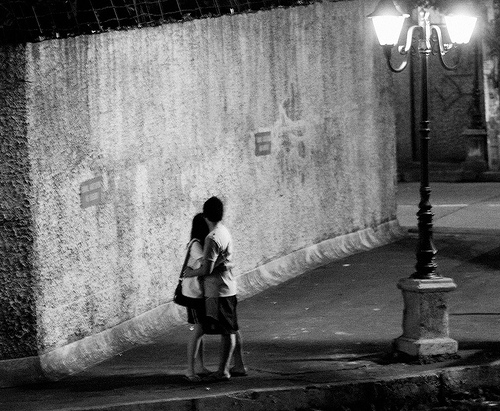When you’re driving down a dark road, late on a moonless night, you’d be lost — literally and figuratively — without your headlights. But what about when you’re walking down a dark road late at night? Road lighting (such as streetlights) that illuminates pedestrian walkways accomplishes more than simply making it easier for a pedestrian to see where he or she is going. Adequate streetlights also provide critical reassurance of safety, according to a study conducted by researchers at the University of Sheffield. (Full text here.)

Streetlights may not guarantee pedestrian traffic, but it’s hard to attract much without them. A study shows that pedestrians feel much safer when there are lights around. Image from Kris Carillo.
The problem with previous studies examining the relationship between streetlights and pedestrians’ self-reported feelings of reassurance is that it’s difficult to construct a study that doesn’t “lead the witness,” so to speak. Once you start talking about dark roads and fear, people start thinking about, well, dark roads and fear.
If you ask a pedestrian if he or she feels safer walking at night on a well-lit road or a dark road, he or she will almost inevitably respond that the well-lit road seems safer. However, if you measured feelings of fear while that same individual walked down a dark road without any prompting questions, the individual’s fear level might not be any different than it would be on a well-lit road.
The Sheffield researchers set out to design an experiment that was as unbiased as possible. Even though lighting was a primary focus of the research questions, researchers didn’t introduce lighting as a prominent variable. Second, the researchers didn’t specifically talk about “safety” and “fear,” both words that elicit automatic, socialized, and deeply embedded responses in many people.
In a series of interviews, participants in the study were simply asked to describe (and provide photographs of) the types of walkways and roads on which they felt confident walking alone at night, and also the types of walkways and roads on which they did not feel confident walking alone at night.
The results? In spite of the fact that researchers took care not to address lighting when framing up the interviews, 92% of participants managed presence or absence of adequate lighting as a reason to feel reassured or, alternatively, as a reason to not feel reassured, when walking in a particular area.
Translation: lighting matters. A lot. In fact, the only factor mentioned with as much frequency as road lighting was potential access to help if it became necessary. Lighting towered over the other factors, including the presence of threatening people, CCTV cameras, personal mobility, and physical features of the walkway.
Of course, a single, dim light pole on a long, winding street won’t quite do the trick. Previous studies suggest that, in most cases, more lighting means more reassurance. The closer manufactured lighting approximates the level of light associated with daytime, the more reassured research subjects report feeling. (Though it’s worth noting that once you go past common daylight levels to blazing lights, the effect diminishes.)
This doesn’t mean that we need street lamps spaced two feet apart, glaring down at our heads as we walk. A study by Nikunen and Korpela found that lighting aimed at natural surrounding elements (e.g., foliage) that still adequately illuminates the area is effective in promoting feelings of safety. More studies suggest that sensor-based lighting that brightens as a person walks by would also be helpful (and save energy costs by not requiring that all lights on a road are on at full volume at all times).
The Sheffield researchers cite additional studies suggesting that improved lighting does more than promote reassurance. It actually catalyzes behavior change, enticing people to walk where they might not have prior to the installation of adequate lighting. The authors are quick to point out that improved lighting can’t solve all the problems associated with problematic areas, and perhaps enticing people to walk through crime-ridden areas isn’t always a positive thing.
All in all, researchers conclude with confidence that improved lighting on roads and pedestrian walkways makes us feel better about our surroundings when we’re walking at night. Adequate lighting might just prompt us to get out the door for some fresh air instead of holing up out of fear. Sounds like a bright plan to us.